Bainitic Transformation and Properties of Low Carbon Carbide-Free Bainitic Steels with Cr Addition
Abstract
:1. Introduction
2. Materials and Methods
2.1. Materials
2.2. Thermal Simulation Experiments
2.3. Microstructure Examinations and Tensile Tests
3. Results and Discussion
3.1. Isothermal Transformation
3.1.1. Dilatation
3.1.2. Microstructures
3.1.3. Mechanical Properties
3.2. Continuous Transformation
3.2.1. Dilatation
3.2.2. Microstructure
3.2.3. Mechanical Properties
4. Conclusions
- (1)
- Chromium addition hinders the isothermal bainitic transformation kinetics and decreases the amount of isothermal transformation due to the decrease in chemical driving force for nucleation and growth of bainite. The hindrance of Cr on bainitic transformation is more significant at higher transformation temperatures because the decreased chemical driving force accounts for a larger proportion.
- (2)
- Chromium addition increases the strength and elongation simultaneously for austempering treatment at a lower temperature. However, when the austempering temperature is higher, the strength increases and the elongation obviously decreases by Cr addition, resulting in the decrease in the product of tensile strength and elongation. In addition, the austempering temperature should be lower in Cr-added steel than that in Cr-free steel in order to obtain better comprehensive properties.
- (3)
- For continuous cooling treatment in the present study, the amount of RA decreases, and the yield strength and tensile strength increases, but the total elongation obviously decreases in Cr added steel due to more amounts of martensite. The product of tensile strength and elongation significantly decreases.
Acknowledgments
Author Contributions
Conflicts of Interest
Abbreviations
| SEM | scanning electron microscope |
| XRD | X-ray diffraction |
| BF | bainite ferrite |
| RA | retained austenite |
| M | martensite |
| LB | lath-like bainite |
| GB | granular bainite |
| PF | polygon ferrite |
| YS | yield strength |
| TS | tensile strength |
| TE | total elongation |
| PSE | product of strength and elongation |
| TRIP | transformation induced plasticity |
References
- Jafari, M.; Ziaei-Rad, S.; Saeidi, N.; Jamshidian, M. Micromechanical analysis of martensite distribution on strain localization in dual phase steels by scanning electron microscopy and crystal plasticity simulation. Mater. Sci. Eng. A 2016, 670, 57–67. [Google Scholar] [CrossRef]
- Huang, Y.Y.; Li, Q.G.; Huang, X.F.; Huang, W.G. Effect of bainitic isothermal transformation plus Q&P process on the microstructure and mechanical properties of 0.2 C bainitic steel. Mater. Sci. Eng. A 2016, 678, 339–346. [Google Scholar]
- Zhou, M.X.; Xu, G.; Wang, L.; Hu, H.J. Combined effect of the prior deformation and applied stress on the bainite transformation. Met. Mater. Int. 2016, 22, 956–961. [Google Scholar] [CrossRef]
- Hu, H.J.; Zurob, H.S.; Xu, G.; Embury, D.; Purdy, G.R. New insights to the effects of ausforming on the bainitic transformation. Mater. Sci. Eng. A 2015, 626, 34–40. [Google Scholar] [CrossRef]
- Zhou, M.X.; Xu, G.; Wang, L.; Xue, Z.L.; Hu, H.J. Comprehensive analysis of the dilatation during bainitic transformation under stress. Met. Mater. Int. 2015, 21, 985–990. [Google Scholar] [CrossRef]
- Ou, M.G.; Yang, C.L.; Zhu, J.; Xia, Q.F.; Qiao, H.N. Influence of Cr content and Q&P&T process on the microstructure and properties of cold-coiled spring steel. J. Alloys Compd. 2017, 697, 43–54. [Google Scholar]
- Hu, H.J.; Xu, G.; Zhou, M.X.; Yuan, Q. Effect of Mo content on microstructure and property of low-carbon bainitic steels. Metals 2016, 6, 173. [Google Scholar] [CrossRef]
- Hu, H.J.; Xu, G.; Wang, L.; Xue, Z.L.; Zhang, Y.L.; Liu, G.H. The effects of Nb and Mo addition on transformation and properties in low carbon bainitic steels. Mater. Des. 2015, 84, 95–99. [Google Scholar] [CrossRef]
- Han, Y.; Kuang, S.; Liu, H.S.; Jiang, Y.H.; Liu, G.H. Effect of chromium on microstructure and mechanical properties of cold rolled hot-dip galvanizing DP450 steel. J. Iron Steel Res. Int. 2015, 22, 1055–1061. [Google Scholar] [CrossRef]
- Wan, S.L.; Gao, H.Y.; Li, Z.Y.; Nakashima, H.; Hata, S.; Tian, W.H. Effect of lower bainite/martensite/retained austenite triplex microstructure on the mechanical properties of a low-carbon steel with quenching and partitioning process. Int. J. Min. Met. Mater. 2016, 23, 303–313. [Google Scholar]
- Jirková, H.; Kučerová, L.; Mašek, B. The effect of chromium on microstructure development during Q-P process. Mater. Today Proc. 2015, 2S, S627–S630. [Google Scholar] [CrossRef]
- Caballero, F.G.; Bhadeshia, H.K.D.H.; Mawella, K.J.A.; Jones, D.G.; Brown, P. Design of novel high strength bainitic steels. Part 1. Mater. Sci. Technol. 2001, 17, 512–516. [Google Scholar] [CrossRef]
- Caballero, F.G.; Bhadeshia, H.K.D.H.; Mawella, K.J.A.; Jones, D.G.; Brown, P. Design of novel high strength bainitic steels. Part 2. Mater. Sci. Technol. 2001, 17, 517–522. [Google Scholar] [CrossRef]
- Caballero, F.G.; Bhadeshia, H.K.D.H. Very strong bainite. Curr. Opin. Solid State Mater. 2004, 8, 251–257. [Google Scholar] [CrossRef]
- Caballero, F.G.; Santofimia, M.J.; Garcia-Mateo, C.; Chao, J.; de Garcia Andres, C. Theoretical design and advanced microstructure in super high strength steels. Mater. Des. 2009, 30, 2077–2083. [Google Scholar] [CrossRef]
- Hasan, H.S.; Peet, M.J.; Avettand-Fènoël, M.-N.; Bhadeshia, H.K.D.H. Effect of tempering upon the tensile properties of a nanostructured bainitic steel. Mater. Sci. Eng. A 2014, 615, 340–347. [Google Scholar] [CrossRef]
- Bracke, L.; Xu, W. Effect of the Cr content and coiling temperature on the properties of hot rolled high strength lower bainitic steel. ISIJ Int. 2015, 55, 2206–2211. [Google Scholar] [CrossRef]
- Tian, J.Y.; Xu, G.; Zhou, M.X.; Hu, H.J.; Wan, X.L. The effects of Cr and Al addition on transformation and properties in low-carbon bainitic steels. Metals 2017, 7, 40. [Google Scholar] [CrossRef]
- Bhadeshia, H.K.D.H. A rationalisation of shear transformations in steels. Acta Metall. 1981, 29, 1117–1130. [Google Scholar] [CrossRef]
- Bhadeshia, H.K.D.H. Bainite in Steels, 2nd ed.; The Institute of Materials: London, UK, 2001; pp. 117–187. [Google Scholar]
- Shipway, P.H.; Bhadeshia, H.K.D.H. The effect of small stresses on the kinetics of the bainite transformation. Mater. Sci. Eng. A 1995, 201, 143–149. [Google Scholar] [CrossRef]
- Zhang, X.X.; Xu, G.; Wang, X.; Embury, D.; Bouaziz, O.; Purdy, G.R.; Zurob, H.S. Mechanical behavior of carbide-free medium carbon bainitic steels. Metall. Mater. Trans. A 2014, 45A, 1352–1361. [Google Scholar] [CrossRef]
- Wang, C.Y.; Shi, J.; Cao, W.Q.; Dong, H. Characterization of microstructure obtained by quenching and partitioning process in low alloy martensitic steel. Mater. Sci. Eng. A 2010, 527, 3442–3449. [Google Scholar] [CrossRef]
- Zhou, M.X.; Xu, G.; Wang, L.; He, B. Effects of austenitization temperature and compressive stress during bainitic transformation on the stability of retained austenite. Trans. Indian Inst. Met. 2016, 69, 1–7. [Google Scholar] [CrossRef]
- Cooman, B.C.D. Structure-properties relationship in TRIP steels containing carbide-free bainite. Curr. Opin. Solid State Mater. 2004, 8, 285–303. [Google Scholar] [CrossRef]
- García-Mateo, C.; Caballero, F.G. The role of retained austenite on tensile properties of steels with bainitic microstructures. Mater. Trans. 2005, 46, 1839–1846. [Google Scholar] [CrossRef]
- Sugimoto, K.; Kobayashi, J.; Ina, D. Toughness of Advanced Ultra High-Strength TRIP-Aided Steels with Good Hardenability. In Proceedings of the International Conference on Advanced Steels 2010 (ICAS 2010), Guilin, China, 9–11 November 2010; Metallurgical Industry Press: Beijing, China, 2010. [Google Scholar]
- Kobayashi, J.; Ina, D.; Yoshikawa, N.; Sugimoto, K. Effects of the addition of Cr, Mo and Ni on the retained austenite characteristics of 0.2% C–Si–Mn–Nb ultrahigh-strength TRIP-aided bainitic ferrite steels. ISIJ Int. 2012, 52, 1894–1901. [Google Scholar] [CrossRef]
- Huang, J.; Poole, W.J.; Militzer, M. Austenite formation during intercritical annealing. Metal. Mater. Trans. A 2004, 35, 3363–3375. [Google Scholar] [CrossRef]
- Quidort, D.; Brechet, Y.J.M. A model of isothermal and non-isothermal transformation kinetics of bainite in 0.5% C Steels. ISIJ Int. 2002, 42, 1010–1017. [Google Scholar] [CrossRef]
- Béché, A.; Zurob, H.S.; Hutchinson, C.R. Quantifying the solute drag effect of Cr on ferrite growth using controlled decarburization experiments. Met. Mater. Trans. A 2007, 38, 2950–2955. [Google Scholar] [CrossRef]
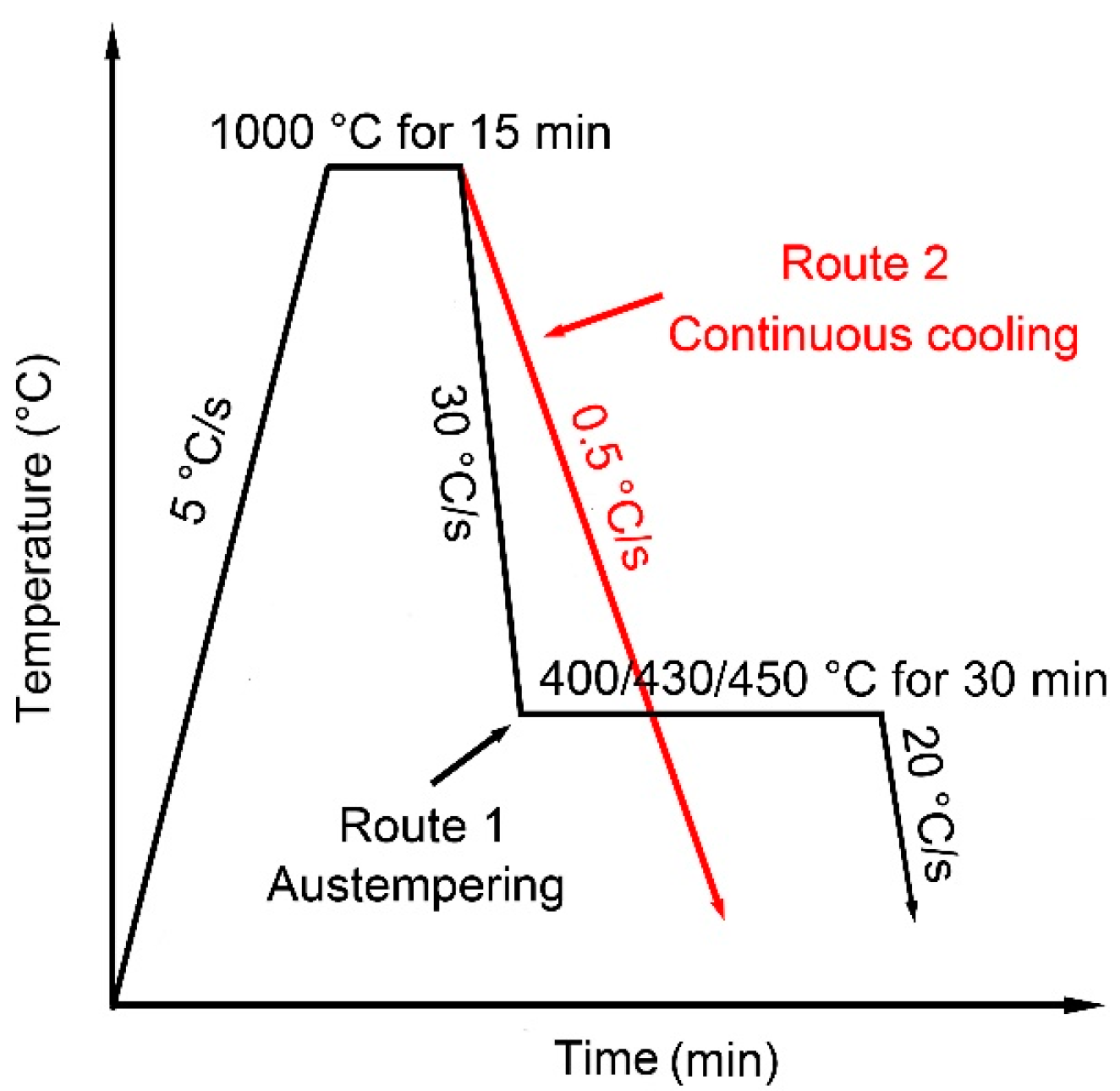
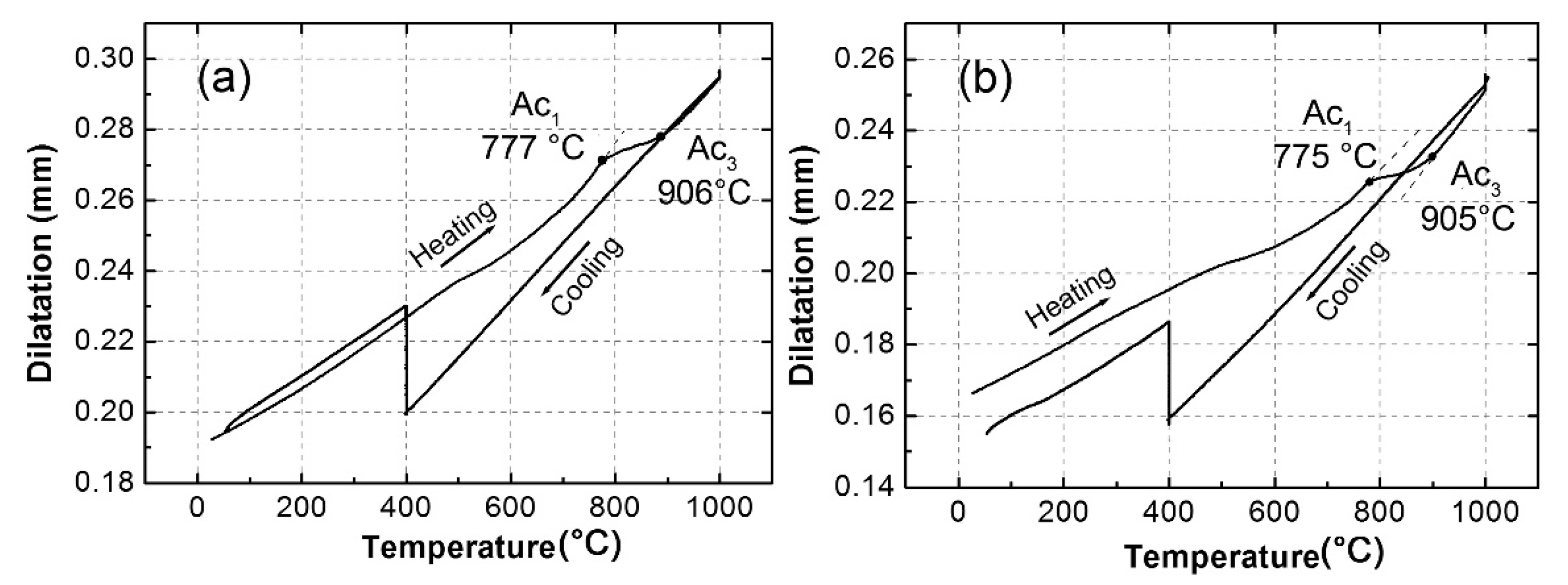

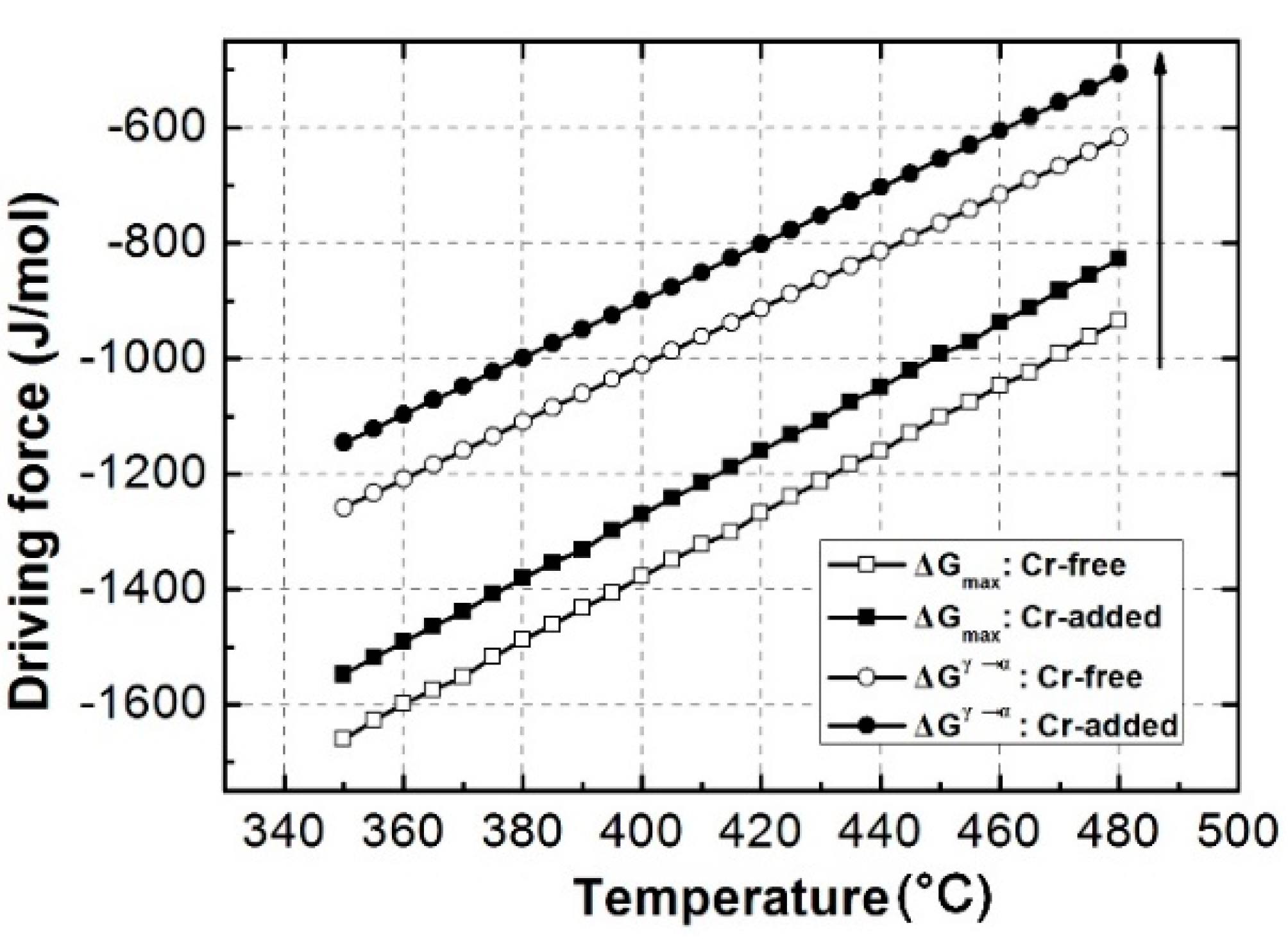
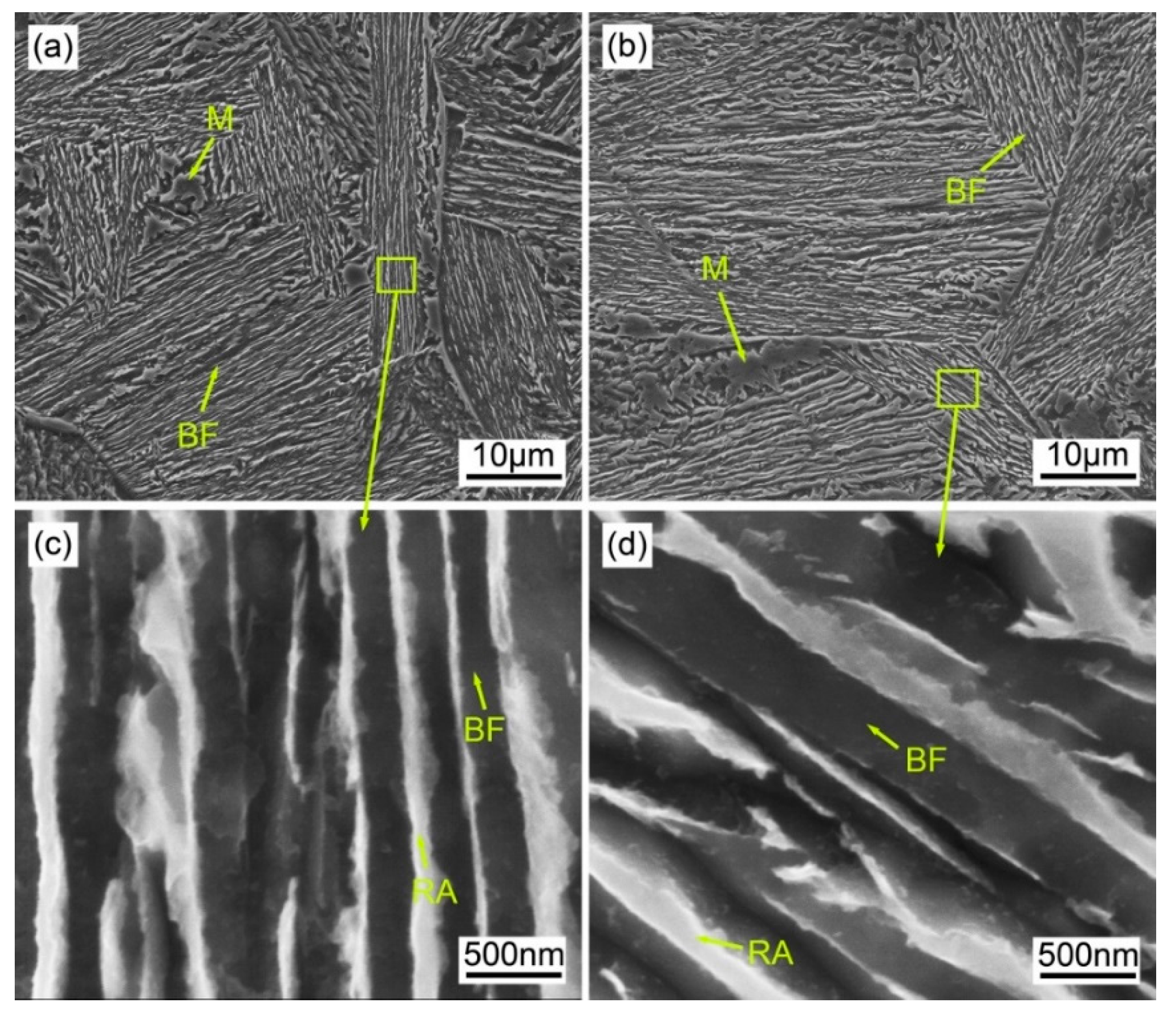

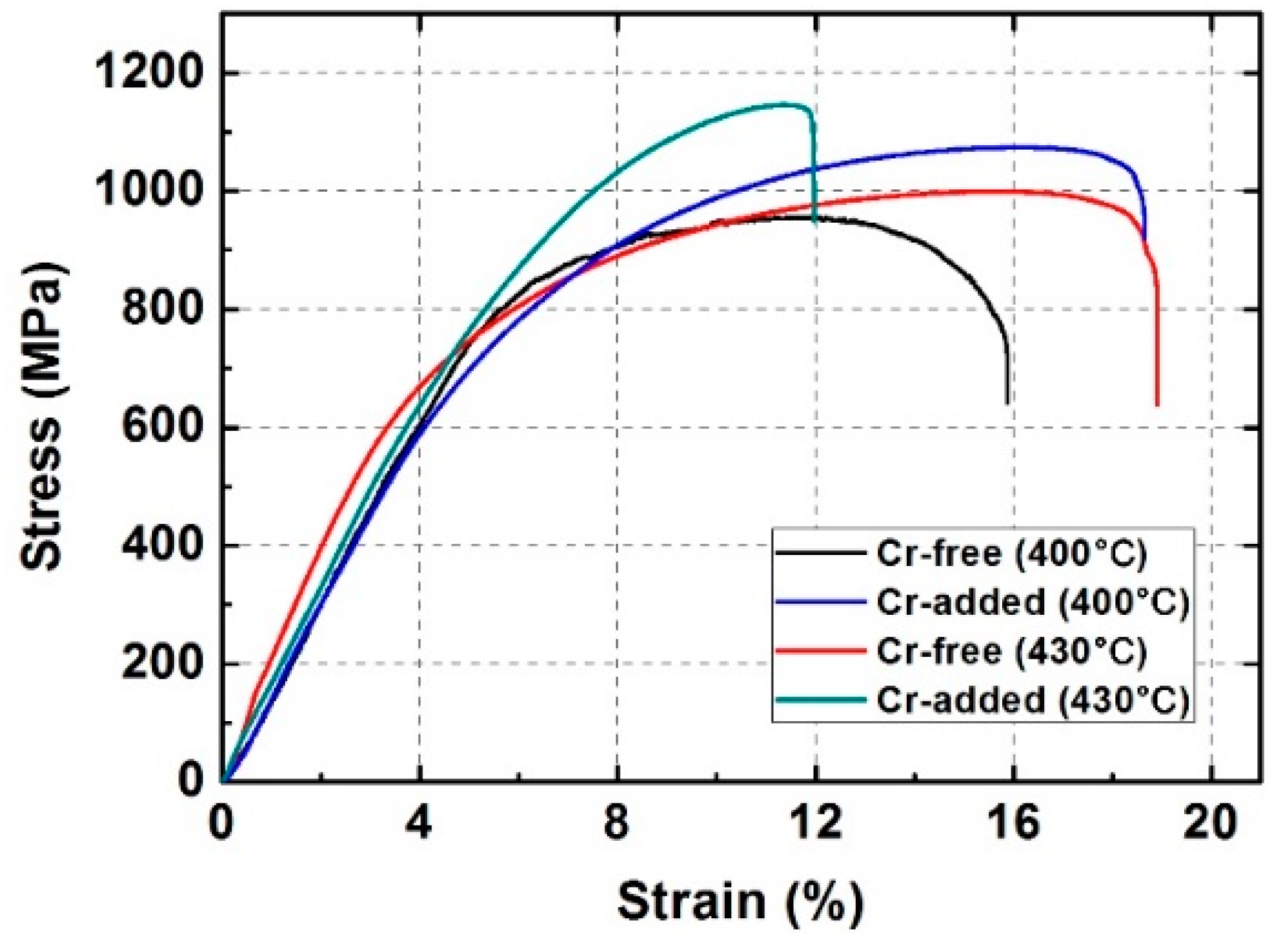

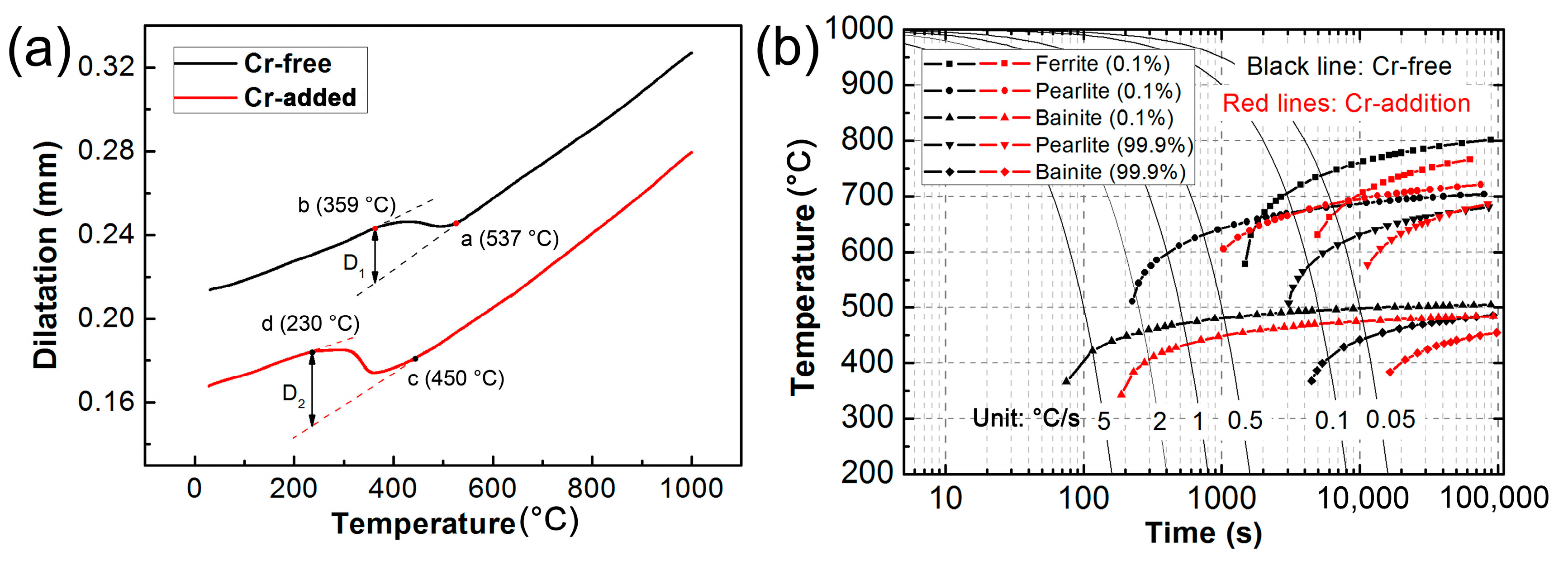

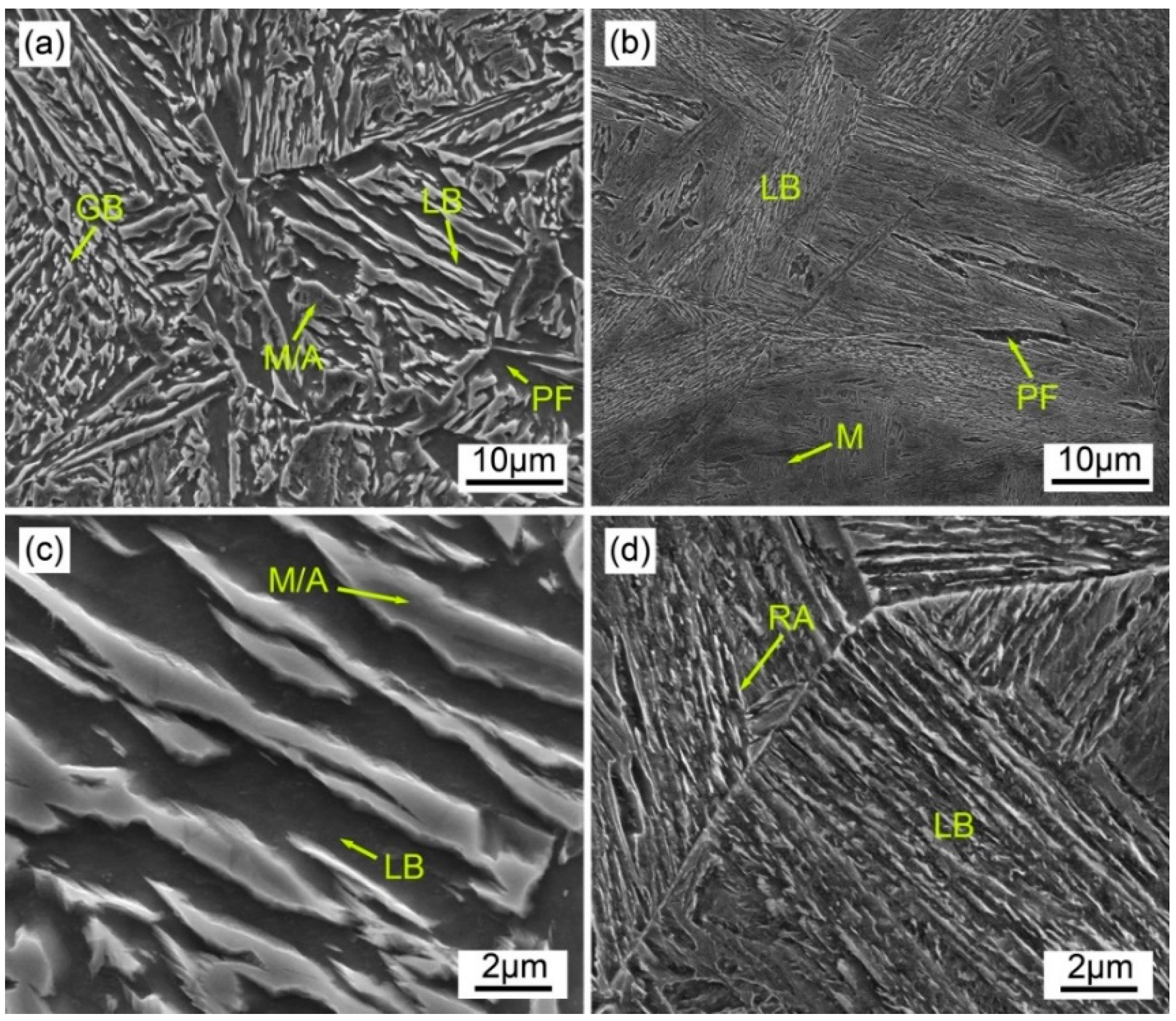
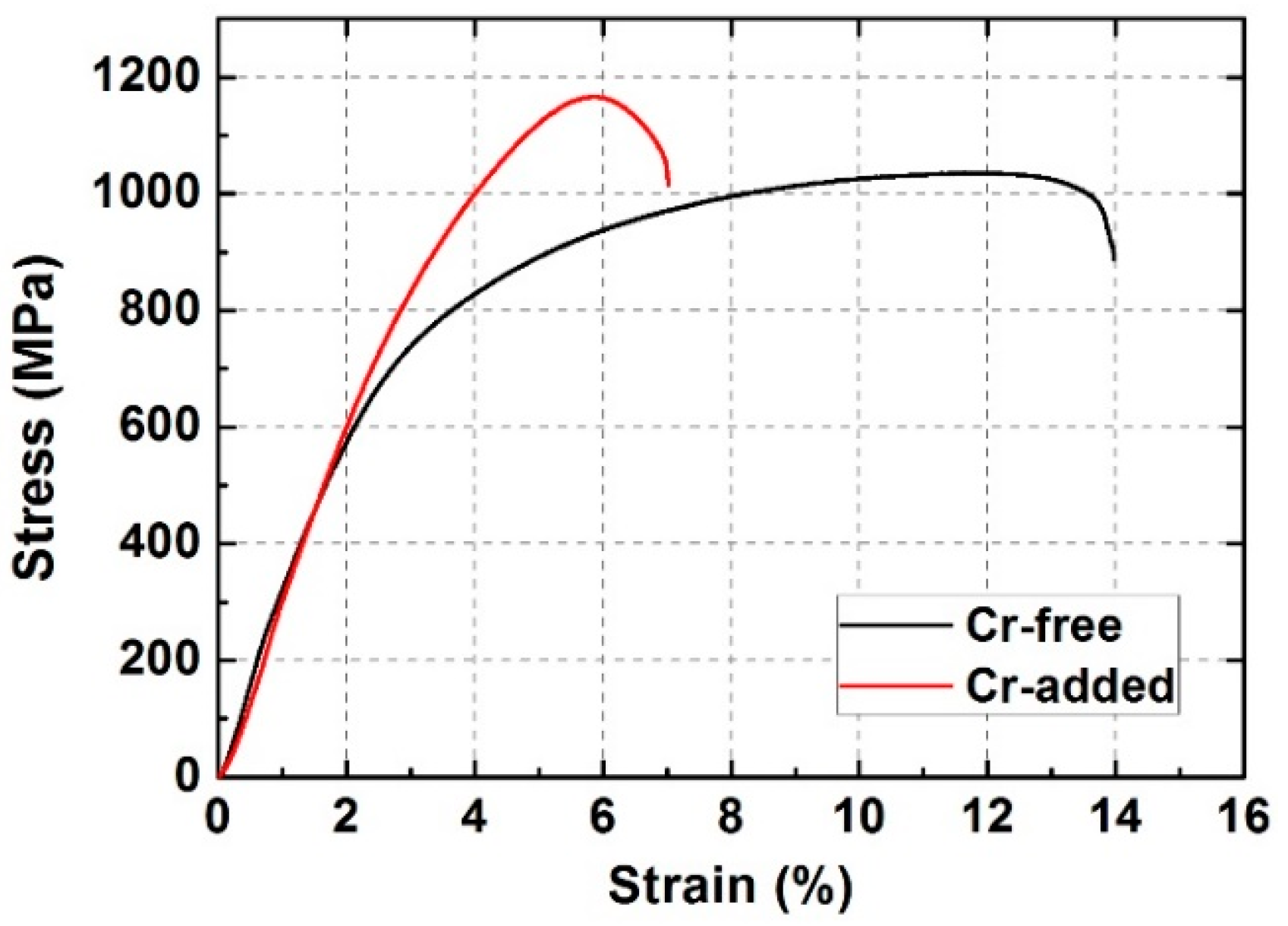
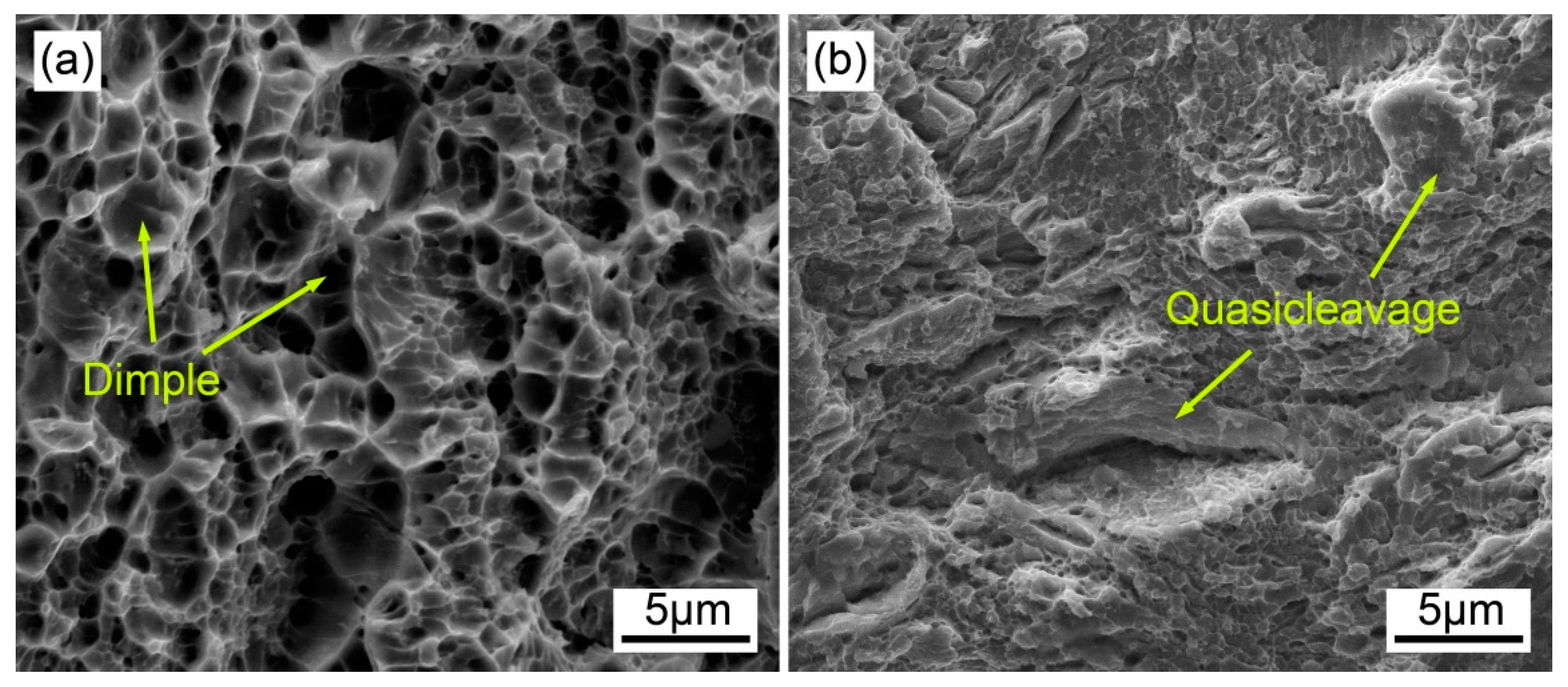
| Steels | C | Si | Mn | Cr | Mo | N | P | S |
|---|---|---|---|---|---|---|---|---|
| Cr-free | 0.218 | 1.831 | 2.021 | / | 0.227 | <0.003 | <0.006 | <0.003 |
| Cr-added | 0.221 | 1.792 | 1.983 | 1.002 | 0.229 | <0.003 | <0.006 | <0.003 |
| Steels | Transformation Temperature (°C) | Experimentally Measured Data (s) | Calculated Data (s) |
|---|---|---|---|
| Cr-free | 400 | 6.0 | 39.4 |
| Cr-added | 400 | 19.4 | 79.8 |
| Cr-free | 430 | 17.9 | 31.0 |
| Cr-added | 430 | 45.0 | 74.3 |
| Cr-free | 450 | 15.3 | 35.8 |
| Cr-added | 450 | 30.1 | 129.8 |
| Steel | YS (MPa) | TS (MPa) | TE (%) | PSE (GPa%) | Vγ (vol. %) | Cγ (wt. %) |
|---|---|---|---|---|---|---|
| Cr-free (400 °C) | 772 ± 16 | 977 ± 36 | 15.8 ± 0.3 | 15.4 ± 0.79 | 6.3 ± 1.1 | 1.18 ± 0.11 |
| Cr-added(400 °C) | 649 ± 16 | 1083 ± 16 | 18.3 ± 0.4 | 19.8 ± 0.52 | 10.1 ± 0.7 | 1.14 ± 0.08 |
| Cr-free (430 °C) | 620 ± 15 | 986 ± 13 | 18.5 ± 0.3 | 18.2 ± 0.55 | 4.0 ± 0.2 | 1.13 ± 0.06 |
| Cr-added (430 °C) | 786 ± 20 | 1185 ± 26 | 11.7 ± 0.9 | 13.9 ± 0.98 | 4.8 ± 0.3 | 0.99 ± 0.03 |
| Cr-free (450 °C) | 795 ± 17 | 1051 ± 19 | 13.6 ± 0.6 | 14.3 ± 0.42 | 3.6 ± 0.4 | 0.96 ± 0.05 |
| Cr-added (450 °C) | 1050 ± 21 | 1263 ± 23 | 5.7 ± 0.3 | 7.2 ± 0.58 | 2.8 ± 0.2 | 0.71 ± 0.03 |
| Steel | YS (MPa) | TS (MPa) | TE (%) | PSE (GPa%) | Vγ (vol. %) | Cγ (wt. %) |
|---|---|---|---|---|---|---|
| Cr-free | 662 ± 13 | 1054 ± 15 | 13.2 ± 0.8 | 13.9 ± 0.56 | 8.7 ± 0.7 | 1.05 ± 0.05 |
| Cr-added | 812 ± 15 | 1145 ± 21 | 6.9 ± 0.2 | 7.9 ± 0.15 | 2.3 ± 0.2 | 0.82 ± 0.04 |
© 2017 by the authors. Licensee MDPI, Basel, Switzerland. This article is an open access article distributed under the terms and conditions of the Creative Commons Attribution (CC BY) license (http://creativecommons.org/licenses/by/4.0/).
Share and Cite
Zhou, M.; Xu, G.; Tian, J.; Hu, H.; Yuan, Q. Bainitic Transformation and Properties of Low Carbon Carbide-Free Bainitic Steels with Cr Addition. Metals 2017, 7, 263. https://doi.org/10.3390/met7070263
Zhou M, Xu G, Tian J, Hu H, Yuan Q. Bainitic Transformation and Properties of Low Carbon Carbide-Free Bainitic Steels with Cr Addition. Metals. 2017; 7(7):263. https://doi.org/10.3390/met7070263
Chicago/Turabian StyleZhou, Mingxing, Guang Xu, Junyu Tian, Haijiang Hu, and Qing Yuan. 2017. "Bainitic Transformation and Properties of Low Carbon Carbide-Free Bainitic Steels with Cr Addition" Metals 7, no. 7: 263. https://doi.org/10.3390/met7070263





